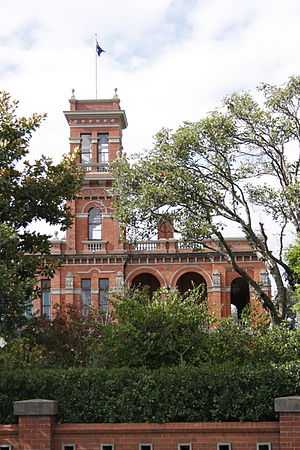Raheen (estate)

Raheen is an historic 19th-century Italianate mansion located at 92 Studley Park Road in the Melbourne, Australia, suburb of Kew. It was built in the 1870s,[1] and its name means "little fort" in Gaelic.
Raheen was once the residence of Archbishop Daniel Mannix, the former Catholic Archbishop of Melbourne.[2] The Catholic Church purchased the property.
The first section of Raheen was commenced in 1870 with an extension added in 1884. It was designed by William Salway and built for Edward Latham of the Carlton Brewery. Sir Henry Wrixon, prominent Melbourne barrister and solicitor, later owned and resided at the property. In 1917 Raheen was purchased by the Catholic Church and became the official residence of Archbishop Mannix, as well as four other Catholic archbishops of Melbourne. In 1981 the Church sold the property and it again reverted to a private residence. Raheen was constructed as a two-storey house in the Italianate style with a four-storey tower over the entrance and single-storey extension. It was designed in an asymmetric and arcaded form, and is built of red brick with cement render. The property retains its garden layout, including an Italianate garden, outbuildings, fence and gates, and internal features including the original stairwell, library, ballroom and cast iron tower stairs.
Raheen is of historic and architectural significance to the State of Victoria.
Raheen is of historic importance because of its association with Melbourne's elite businessmen through Latham and Wrixon, and illustrates not only the importance of the brewery business and the legal profession in nineteenth century Melbourne, but also the importance of a residence in indicating success and status in society. The house is of historic importance through its association with the Catholic Church and illustrates the status sought by church hierarchy for Melbourne's Catholics and the Church prior to the mid-twentieth century. It is also historically important because of its association with Archbishop Dr Daniel Mannix who played a significant role within the Melbourne Archdiocese, as also in Melbourne politics particularly during the Conscription debates of the First World War. Raheen is architecturally important in exhibiting an unusual integration of features in the combination of red brick and cement rendering. The house is architecturally important in exhibiting good design and aesthetic characteristics of the Italianate style, as well as in internal features and garden design.
It was purchased in 1981 by the Australian businessman Richard Pratt and his family and currently is not open to the public. Pratt extensively renovated the house and gardens, including the addition of a new wing designed by Glen Murcutt.[1]
The site is listed on the Victorian Heritage Register.[3]
Notes
- ↑ 1.0 1.1 ABC-TV, Gardening Australia - Raheen fact sheet
- ↑ James Kirby and Tony Stephens (obituary) "Tycoon with an immense, combative energy", Sydney Morning Herald, 29 April 2009
- ↑ "Raheen, Victorian Heritage Register (VHR) Number H0515, Heritage Overlay HO128". Victorian Heritage Database. Heritage Victoria.
Coordinates: 37°48′19″S 145°01′00″E / 37.8053°S 145.0167°E